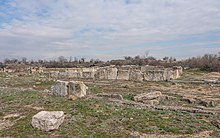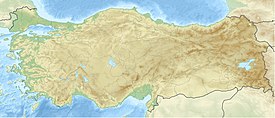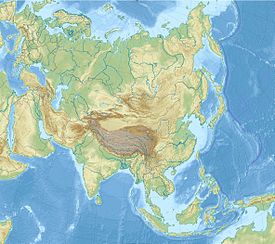This article needs additional citations for verification. (February 2016) |
Colossae (/kəˈlɒsi/; ‹See Tfd›Greek: Κολοσσαί) was an ancient city of Phrygia in Asia Minor, and one of the most celebrated cities of southern Anatolia (modern Turkey). The Epistle to the Colossians, an early Christian text which identifies its author as Paul the Apostle, is addressed to the church in Colossae. A significant city from the 5th century BC onwards, it had dwindled in importance by the time of Paul, but was notable for the existence of its local angel cult.[1] It was part of the Roman and Byzantine province of Phrygia Pacatiana, before being destroyed in 1192/3 and its population relocating to nearby Chonae (Chonai, modern-day Honaz).
Κολοσσαί (Kolossoí) | |
 Ruins of Colossae | |
| Region | Phrygia |
|---|---|
| Coordinates | 37°47′12″N 29°15′36″E / 37.78667°N 29.26000°E |
| Part of | West Asia |


Location and geography
editColossae was located in Phrygia, in Asia Minor.[2] It was located 15 km (9.3 mi) southeast of Laodicea on the road through the Lycus Valley near the Lycus River at the foot of Mt. Cadmus, the highest mountain in Turkey's western Aegean Region, and between the cities Sardeis and Celaenae, and southeast of the ancient city of Hierapolis.[3][4] At Colossae, Herodotus describes how, "the river Lycos falls into an opening of the earth and disappears from view, and then after an interval of about five furlongs it comes up to view again, and this river also flows into the Maiander."[5] Despite a treacherously ambiguous cartography and history, Colossae has been clearly distinguished in modern research from nearby Chonai (Χῶναι), now called Honaz, with what remains of the buried ruins of Colossae ("the mound") lying 3 km (1.9 mi) to the north of Honaz.[6][7][8]
Origin and etymology of place name
editThe medieval poet Manuel Philes incorrectly imagined that the name Colossae was connected to the Colossus of Rhodes.[9] More recently, in an interpretation that ties Colossae to an Indo-European root that happens to be shared with the word kolossos, Jean-Pierre Vernant has connected the name to the idea of setting up a sacred space or shrine.[10] Another proposal relates the name to the Greek kolazo 'to punish'.[9] Others believe the name derives from the manufacture of its famous dyed wool, or colossinus.[11]
History
editBefore the Pauline period
editThis section needs expansion with: a cohesive account of the history of the municipality and its peoples and cultures, as appear in many texts on the subject. You can help by adding to it. (February 2016) |
The first mention of the city may be in a 17th-century BC Hittite inscription, which speaks of a city called Huwalušija, which some archeologists believe is a reference to early Colossae. The 5th-century geographer Herodotus first mentions Colossae by name and as a "great city in Phrygia", which accommodates the Persian king Xerxes I while en route to wage war against the Greeks in the Greco-Persian Wars– showing the city had already reached a certain level of wealth and size by this time.[12] Writing in the 5th century BC, Xenophon refers to Colossae as "a populous city, wealthy and of considerable magnitude".[13] It was famous for its wool trade. Strabo notes that the city drew great revenue from the flocks, and that the wool of Colossae gave its name to colour colossinus.[14]
In 396 BC, Colossae was the site of the execution of the rebellious Persian satrap Tissaphernes, who was lured there and slain by an agent of the party of Cyrus the Younger.[15]
Pauline period
editAlthough during the Hellenistic period, the town was of some mercantile importance, by the 1st century it had dwindled greatly in size and significance.[16] Paul's letter to the Colossians points to the existence of an early Christian community. Colossae was home to the miracle near the Archangel church, where a sacristan named Archipos witnessed, how the Archangel Michael thwarted a plan by the heathens to destroy the church by flooding it with the waters of near-by mountain rivers. The Eastern Orthodox Church commemorates this feast on 6(19) September.
The canonical biblical text Epistle to the Colossians is addressed to the Christian community in Colossae. The epistle has traditionally been attributed to Paul the Apostle due to its autobiographical salutation and style,[17][18] but some modern critical scholars now believe it to be written by another author some time after Paul's death.[19] It is believed that one aim of the letter was to address the challenges that the Colossian community faced in its context of the syncretistic Gnostic religions that were developing in Asia Minor.[20]
According to the Epistle to the Colossians, Epaphras seems to have been a person of some importance in the Christian community in Colossae,[21] and tradition presents him as its first bishop.[22] The epistle also seems to imply that Paul had never visited the city, because it only speaks of him having "heard" of the Colossians' faith,[23] and in the Epistle to Philemon Paul tells Philemon of his hope to visit Colossae upon being freed from prison.[24] Tradition also gives Philemon as the second bishop of the see.
The city was decimated by an earthquake in the 60s AD, and was rebuilt independent of the support of Rome.[25]
The Apostolic Constitutions list Philemon as a bishop of Colossae.[26] On the other hand, the Catholic Encyclopedia considers Philemon doubtful.[27]
The first historically documented bishop is Epiphanius,[when?] who was not personally at the Council of Chalcedon, but whose metropolitan bishop Nunechius of Laodicea, the capital of the Roman province of Phrygia Pacatiana, signed the acts on his behalf.[citation needed]
Byzantine period and decline
editThis section needs expansion with: with SOURCED material relevant to its destruction by the Saracens and the Turks. You can help by adding to it. (February 2016) |
The city's fame and renowned status continued into the Byzantine period, and in 858, it was distinguished as a Metropolitan See. The Byzantines also built the church of St. Michael in the vicinity of Colossae, one of the largest church buildings in the Middle East. Nevertheless, sources suggest that the town may have decreased in size or may even been completely abandoned due to Arab invasions in the seventh and eighth centuries, forcing the population to flee to resettle in the nearby city of Chonai (modern day Honaz).[11]
Colossae's famous church was destroyed in 1192/3 during the Byzantine civil wars. It was a suffragan diocese of Laodicea in Phyrigia Pacatiana but was replaced in the Byzantine period by the Chonae settlement on higher ground.[4]
Modern study and archeology
editThis section needs expansion with: with SOURCED material relevant to the history of its mapping and historical and literary discussion (see further reading), and on plans for its excavation. You can help by adding to it. (February 2016) |
Most archeological attention has been focused on nearby Laodicea and Hierapolis.[28] Excavations of Colossae began in 2021 led by Bariş Yener of Pammukale University in Denizli.[29] The first several years involve surface surveys to analyze pottery and survey the landscape. They hope to start digging in 2023-24.
The site exhibits a biconical acropolis almost 100 feet (30 m) high, and encompasses an area of almost 22 acres (8.9 ha). On the eastern slope there sits a theater which probably seated around 5,000 people, suggesting a total population of 25,000–30,000 people. The theater was probably built during the Roman period, and may be near an agora that abuts the cardo maximus, or the city's main north–south road. Ceramic finds around the theater confirm the city's early occupation in the third and second millennia BC. Northeast of the tell, and most likely outside the city walls, a necropolis displays Hellenistic tombs with two main styles of burial: one with an antecedent room connected to an inner chamber, and tumuli, or underground chambers accessed by stairs leading to the entrance. Outside the tell, there are also remains of sections of columns that may have marked a processional way, or the cardo. Today, the remains of one column marks the location where locals believe a church once stood, possibly that of St. Michael.[28] Near the Lycus River, there is evidence that water channels had been cut out of the rock with a complex of pipes and sluice gates to divert water for bathing and for agricultural and industrial purposes.[30]
Modern legacy
editThe holiness and healing properties associated with the waters of Colossae during the Byzantine era continue to this day, particularly at a pool fed by the Lycus River at the Göz picnic grounds west of Colossae at the foot of Mt. Cadmus. Locals consider the water to be therapeutic.[31]
See also
editNotes and references
edit- ^ Piccardi, Luigi (2007). "The AD 60 Denizli Basin earthquake and the apparition of Archangel Michael at Colossae (Aegean Turkey)". Geological Society, London, Special Publications. 273 (1): 95–105. Bibcode:2007GSLSP.273...95P. doi:10.1144/GSL.SP.2007.273.01.08. S2CID 129096978.
- ^ Losch, Richard R. (2005). The Uttermost Part of the Earth: A Guide to Places in the Bible. Wm. B. Eerdmans Publishing. ISBN 9780802828057.
- ^ Trainor, Michael, Colossae - Colossal In Name Only? Biblical Archaeology Review, March/April 2019, Vol. 45, No. 2, p. 45.
- ^ a b Cancik, Hubert; Schneider, Helmuth; Salazar, Christine F; Orton, David E. (2002–2010). Brill's New Pauly: encyclopaedia of the ancient world. Antiquity. [CAT-CYP]. Leiden: Brill. p. 579. ISBN 9004122664. OCLC 54952013.
- ^ The History of Herodotus — Volume 2 by Herodotus.
- ^ Cadwallader, Alan H.; Trainor, Michael (2011). "Colossae in Space and Time: Overcoming Dislocation, Dismemberment and Anachronicity". In Cadwallader, Alan H.; Trainor, Michael (eds.). Colossae in Space and Time: Linking to an Ancient City. Novum Testamentum et Orbis Antiquus/Studien zur Umwelt des Neuen Testaments (NTOA/StUNT), Vol. 94. Göttingen, GER: Vandenhoeck & Ruprecht. pp. 9–47. ISBN 978-3647533971. Retrieved 17 February 2016. The case is made exhaustively in this book, over pages 11-37, wherein it states—after dispensing with a further false association of the ancient city with the island of Rhodes the home of The Colossus of Rhodes, which resulted in its being misplaced for hundreds of years (by "almost 200 kilometers to the south-west," p. 18ff)—in summary, that: "Colossae's various positions on early maps confirmed the confusion over identity [opening section title]. Cartographers positioned Colossae to the west (rather than south-east) of Laodicea7 or, as 'Conos', between Laodicea to the north-west and Hieropolis to the north-east.8 [p. 11] … 'Chonos' or some other guesttimation of the spelling of Honaz12 sometimes subsumed Colossae. [p. 13] … The inhabitants of the immediate vicinity of the ancient site [Colossae, which had ceased to exist] were shackled in bureaucratic tabulation for tax purposes to the town of Honaz. [p. 14] … When Frances Arundell's sketch of Honaz appeared in 1834, the town had descended from the mountain heights [it was a mountain fortress, Honazdağ] but it was similarly labelled, albeit after the fashion of Nicetas Choniates: 'Chonas, … anciently Colossae'.98 [p. 32] … The question was whether Honaz and Colossae were to be equated or separated and whether the contemporary Honaz was the means to pinpoint the ancient… site. [p. 33] … William Hamilton became the one credited with the separation of Colossae from Chonai with the former's location at the mound three kilometers to the north of Honaz.108 [p. 35] … Two photographs of the 'Ruines de Colossae' and 'Chonas' by Henri Carmignac published toward the endif the nineteenth century finally eliminated the concordant visualisation of the places that had been the legacy of Arundell (Fig. 11).113 [p. 37]." For much earlier sources presenting the errant historical opinion, see the next two citations.
- ^ Smith, William (1854). "Colossae". Dictionary of Greek and Roman Geography. London: Walton & Maberly.
- ^ Pétridès, Sophrone (1908). "Colossae". Catholic Encyclopedia. Vol. 4. New York: Robert Appleton Company.
- ^ a b Cadwallader, Alan H., and Michael Trainor (2011). "Colossae in Space and Time: Overcoming Dislocation, Dismemberment and Anachronicity". In Cadwallader and Trainor, eds. Colossae in Space and Time: Linding to an Ancient City. Vandenhoeck & Ruprecht. pp. 18–19.
- ^ Vernant, Jean-Pierre (2006) [1965]. Myth and Thought Among the Greeks. Third edition of a translation from the French originally published in 1983, from a French work published in 1965. Zone Books. p. 321.
- ^ a b Trainor, Michael, Colossae - Colossal In Name Only? Biblical Archaeology Review, March/April 2019, Vol. 45, No. 2, p. 47.
- ^ Trainor, Michael, Colossae - Colossal In Name Only? Biblical Archaeology Review, March/April 2019, Vol. 45, No. 2, p. 46.
- ^ Watson, J. S. (2007). The First Four Books of Xenophon's Anabasis. Project Gutenberg. p. 6.
- ^ The Geography of Strabo, Volume 2 (of 3) by Strabo. p. 334.
- ^ . Encyclopædia Britannica. Vol. 26 (11th ed.). 1911.
- ^ Cadwallader, Alan H.; Trainor, Michael (7 December 2011). Colossae in Space and Time: Linking to an Ancient City. Vandenhoeck & Ruprecht. ISBN 9783647533971.
- ^ Beale, G.K. (2019). Yarbrough, Robert W; Jipp, Joshua W (eds.). Colossians and Philemon. Baker Exegetical Commentary of the New Testament. Baker Academic. pp. 5–8. ISBN 978-0-8010-2667-6.
- ^ "Colossians 1:1 Paul, an apostle of Christ Jesus by the will of God, and Timothy our brother, 2 To God's holy people in Colossae, the faithful brothers and sisters in Christ".
- ^ Cross, F.L., ed. (2005), "Colossians, Epistle to the", The Oxford Dictionary of the Christian Church, New York: Oxford University Press.
- ^ Bruce, Frederick Fyvie (1980) [1969]. New Testament History. New York: Galilee/Doubleday. pp. 415f. ISBN 0385025335. Retrieved 17 February 2016.
[Quoting:] Those churches which claimed an apostolic foundation attached great importance to the maintenance of the teaching which they had originally received. There were powerful forces at work in many of them which militated against the maintenance of that teaching; chief among these were those tendencies which in a few decades blossomed forth in the elaborate systems of the various schools of Gnosticism. One form of incipient Gnosticism is the syncretistic angel-cult of nonconformist Jewish foundation and pagan superstructure attacked in the Epistle to the Colossians.
- ^ (Col. 1:7; 4:12)
- ^ Pétridès, Sophrone (1908). "Colossae". Catholic Encyclopedia. New York: Robert Appleton Company.
Colossæ was the home of...Onesimus and Epaphras, who probably founded the Church of Colossæ.
- ^ Col. 1:4
- ^ Philemon 1:22
- ^ "Background on Colossae and the Colossians | Bible Commentary | Theology of Work". www.theologyofwork.org. Retrieved 7 April 2020.
- ^ "(Book VII) Section 4". Apostolic Constitutions. From Ante-Nicene Fathers, Vol. 7. Edited by Alexander Roberts, James Donaldson, and A. Cleveland Coxe. Translated by James Donaldson. Buffalo, NY: Christian Literature Publishing Co. 1886. Retrieved 28 December 2018.
Of Colossæ, Philemon.
- ^ Pétridès, Sophrone (1908). "Colossae". Catholic Encyclopedia. New York: Robert Appleton Company. Retrieved 28 December 2018.
Besides St. Epaphras... Archippus and Philemon, especially the latter, are very doubtful.
- ^ a b Trainor, Michael, Colossae - Colossal In Name Only? Biblical Archaeology Review, March/April 2019, Vol. 45, No. 2, p. 48.
- ^ Borges, Jason (6 September 2022). "Excavations at Colossae". Biblical Turkey. Retrieved 12 November 2024.
- ^ Trainor, Michael, Colossae - Colossal In Name Only? Biblical Archaeology Review, March/April 2019, Vol. 45, No. 2, p. 49.
- ^ Trainor, Michael, Colossae - Colossal In Name Only? Biblical Archaeology Review, March/April 2019, Vol. 45, No. 2, p. 50.
This article incorporates text from a publication now in the public domain: Easton, Matthew George (1897). "Colossae". Easton's Bible Dictionary (New and revised ed.). T. Nelson and Sons.
Further reading
edit- Bruce, Frederick Fyvie (1980) [1969]. New Testament History. New York: Galilee/Doubleday. ISBN 0-38502533-5. Retrieved 17 February 2016.
- This article incorporates text from a publication now in the public domain: Easton, Matthew George (1897). "Colossae". Easton's Bible Dictionary (New and revised ed.). T. Nelson and Sons.[needs update]
- Bennett, Andrew Lloyd. "Archaeology From Art: Investigating Colossae and the Miracle of the Archangel Michael at Kona." Near East Archaeological Society Bulletin 50 (2005):15–26.
External links
edit- Map and pictures of ruins
- . Encyclopædia Britannica. Vol. 6 (11th ed.). 1911. pp. 725–726.

